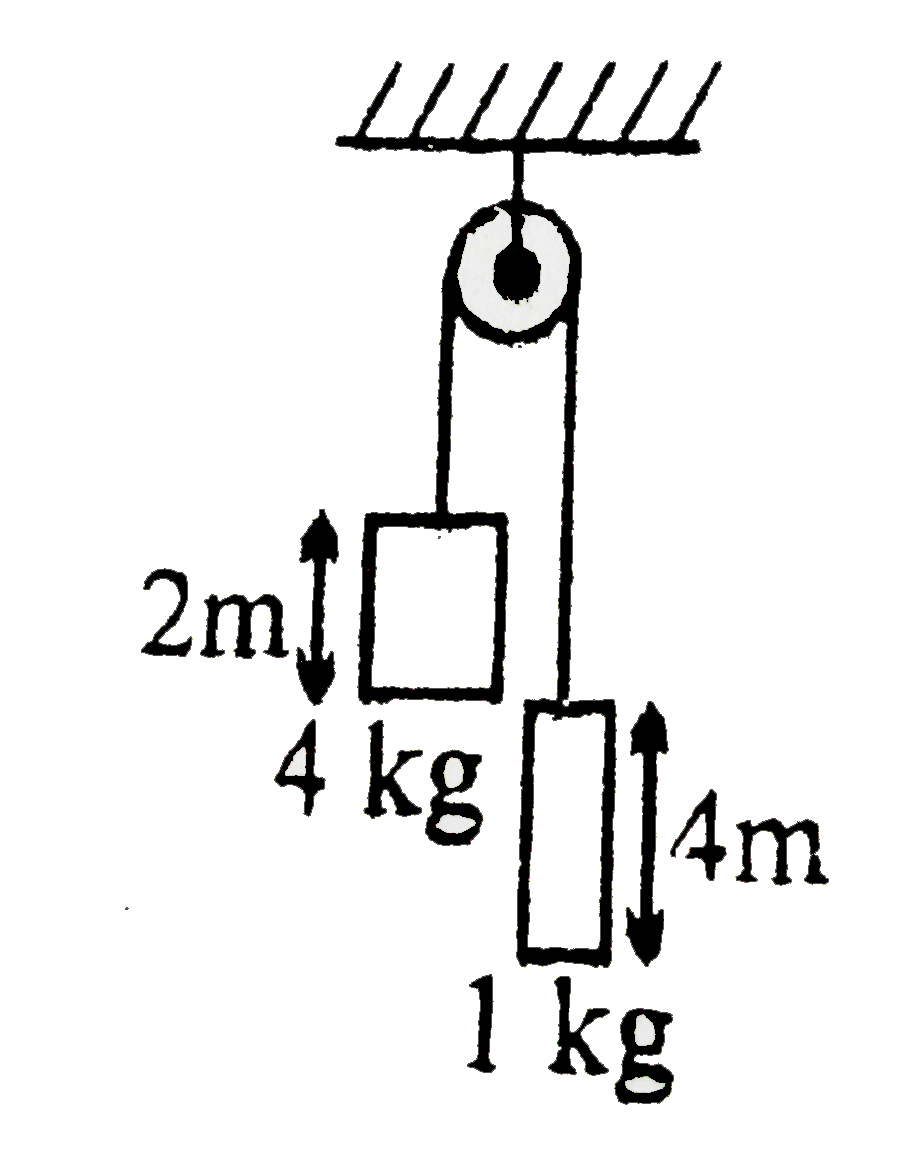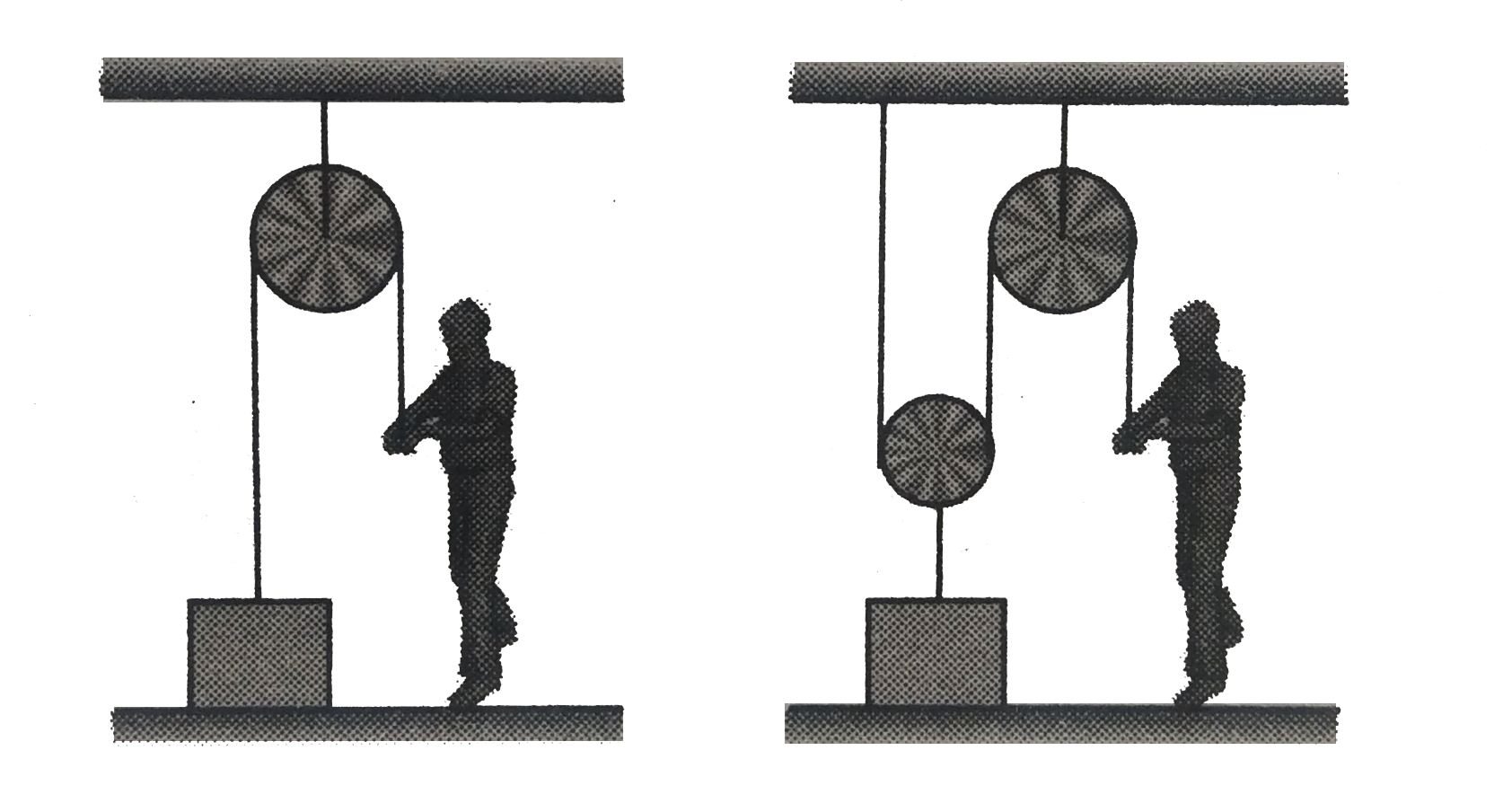In the figure show , a person wants raise a block lying on the ground to a height h . In which case he has to exert more force. Assume pulleys and strings are light .

Fig (i)
Fig (ii)
Same in both
Cannot be determined
The correct Answer is:A
If force applied by man is F. Then in first figure force transferred to the block is F, while in second figure force transferred to the block is 2F.

Topper's Solved these Questions
- LAWS OF MOTIONBOOK - DC PANDEYCHAPTER - LAWS OF MOTIONEXERCISE - Objective Question
32 Videos
- LAWS OF MOTIONBOOK - DC PANDEYCHAPTER - LAWS OF MOTIONEXERCISE - Comprehension
9 Videos
- LAWS OF MOTIONBOOK - DC PANDEYCHAPTER - LAWS OF MOTIONEXERCISE - Exercise 8.5
2 Videos
- KINEMATICS 1BOOK - DC PANDEYCHAPTER - KINEMATICS 1EXERCISE - INTEGER_TYPE
15 Videos
- LAWS OF THERMODYNAMICSBOOK - DC PANDEYCHAPTER - LAWS OF THERMODYNAMICSEXERCISE - Level 2 Subjective
18 Videos
Similar Questions
In figure shown, both blocks are released from rest. Length of 4 kg block is 2 m and of 1 K g is 4 m . Find the time they take to cross each other ? Assume pulley to be light and string to be light and inelastic .

View SolutionUnder the condition shown in figure. Find out the minimum value of horizontal force F2 on pulley, which can be applied without causing any motion (assume pulley& strings are light)

View Solution
Knowledge Check
In the figure shown, a person wants to raise a block lying on the ground to a height h. in both the cases if time required is same then in which case he has to exert more force. Assume pulleys and strings light.
 A(i)B(ii)Csame in bothDcannot be determined
A(i)B(ii)Csame in bothDcannot be determinedIn fig., a person wants to rise a block lying on the ground to a height h. In both the cases, if the time required is same, then in which case he has to exert more force? Assuem pulleys and strigns light.
 A(i)B(ii)CSame in bothDCannot be determined
A(i)B(ii)CSame in bothDCannot be determinedThere blocks a,b and c of massses 10 kg ,10 kg and 20 kg respectivaly are arrenged as shown in figure all the surface are frictionless and string is inextensible A constant force F= 20N MN is applied on block a as shown .pulley and string are light . part of block a as shown . pulley and string are light . part of the string connecting both pulleys is vertical and part of hte stings connecting pulleys with masses a and b are horizontal .
 AAcceleration of block b 0.5m/s2BAcceleration of block b is 1m/s2CTension in the string is 10NDAcceleration of block c is 0.5m/s2
AAcceleration of block b 0.5m/s2BAcceleration of block b is 1m/s2CTension in the string is 10NDAcceleration of block c is 0.5m/s2
In the arrangement shown in figure, pulley is smooth and massless and all the strings are light. Let F1 be the force exerted on the pulley in case (i) and F2 the force in case (ii). Then :

View SolutionThe pulley shown in figure has a moment of inertia I about it's axis and its radius is R. Find the magnitude of the acceleration of the two blocks. Assume that the string is light and does not slip on the pulley.

View SolutionFigure shows a block A constrained to slide along the inclined plane of the wedge B shown. Block A is attached with a string which passes through three ideal pulleys and connected to the wedge B. If wedge is pulled toward right with an acceleration a, find
(a) the acceleration of the block with respect to wedge
(b) the acceleration of the block with respect to ground.

View SolutionThe system starts from rest and A attains a velocity of 5m/s after it has moved 5m toward right. Assuming the arrangement to be frictionless everywhere and pulley and string to be light, the value of the constant force F applied on A is:

View SolutionThree blocks of masses m1,m2 and M are arranged as shown in figure. All the surfaces are fricationless and string is inextensible. Pulleys are light. A constant force F is applied on block of mass m1. Pulleys and string are light. Part of the string connecting both pulleys is vertical and part of the strings connecting pulleys with masses m1 and m2 are horizontal.

(P)Accleration of mass m1(1)Fm1(Q)Acceleration of massm2(2)Fm1+m2(R)Acceleration of mass M(3)zero(S)Tension in the string(4)m2Fm1+m2
View Solution